On Friday, January 28th I attended my first barista championship—the Northwest Regional Barista Championship (NWRBC), held in Tacoma, Washington. If you didn’t know that the NWRBC was happening, don’t feel too bad—I didn’t even know it existed until last fall, when I interviewed Brandon Arends.
Brandon is probably the biggest coffee enthusiast I have ever met—he is as enthusiastic, knowledgeable and opinionated as any of the highly-skilled baristas and café owners I have met around Portland—so I was glad when he agreed to go to Tacoma with me. On the trip up, he told me all about the competition and about the experiences he had volunteering at previous regional and national barista championships.
Before we went up to Tacoma, Brandon got in touch with Marcus Boni, Marketing Director for the Specialty Coffee Association of America (SCAA), to see if we could volunteer. Brandon had worked for him at the NWRBC in 2009 when it was held in Portland, and Marcus was happy to let us volunteer. I was excited because volunteering would give me a closer look into the competition.
We left Portland on Friday about 7am, giving us time to stop for coffee along the way. We stopped at Lava Java, near Ridgefield, Washington, which turned out to be a great stop, despite my initial reservations. I’ll share that story with you soon.
The NWRBC is the first step in the path toward the US Barista Championship (USBC). Finalists at the regional level are eligible to compete in the USBC, which you might say is kind of like the Miss America pageant for coffee nerds. The Northwest region covers Alaska, Washington, Oregon, Idaho, Montana and Wyoming and anyone who lives or works in one of those states is eligible to compete at the NWRBC.
Walking into the competition area at the Tacoma Convention Center felt somewhat familiar, even though it was my first time attending the championship. The large conference room smelled just like walking into a specialty coffee shop in Portland. The sweet, toasty smell of freshly-ground coffee greeted us as we entered, and I saw many faces in the room that I recognized. Some of them had been at Coffee Fest in Seattle and others I had seen or talked to around Portland. One of the first people I recognized was Nathanael May, from Portland Roasting Coffee. He had come up earlier in the week to get certified as a judge for the competition. He told me that the certification test was more difficult than he thought it would be, but he passed and was going to judge the second day of competition.
Brandon and I went over to talk to Marcus, who assigned us to station maintenance. It would be our job clean up the stage after each barista competed and make sure that the espresso machines were immaculate.
The room was a typical conference room, and up front there were three different performance areas. Each of the areas consisted of a Nuova Simonelli espresso machine, an adjoining preparation table and a high presentation table where the four sensory judges would sit and taste the drinks.
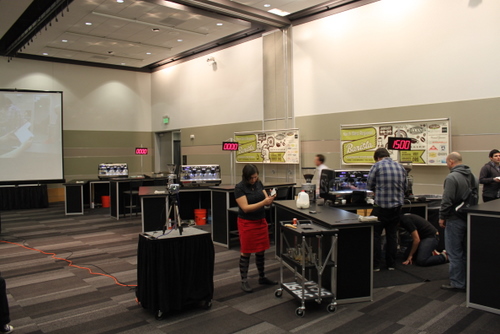
The competition works like this: competitors have 15 minutes of preparation time to set up their area. The baristas set out their tools, pitchers and cups, go over any last-minute adjustments on the grinders and set out any other props they have for the presentation. The competition is a combination of skill and style, so many of the set-ups were fairly elaborate. The baristas set out napkins and saucers for each of the sensory judges and many of the place settings resembled that of a fancy restaurant.
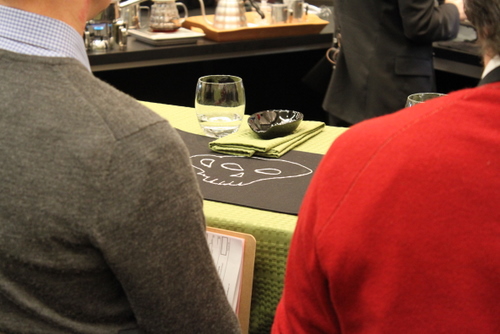
At the end of the 15-minute prep time, the judges come out and shake hands with the competitor before taking their positions. Each competitor is judged by a total of seven people: two technical judges, four sensory judges and a head judge. The technical judges hover around the grinders and espresso machine as the baristas grind the coffee, pull shots and steam and pour the milk. They are looking at all of the little details that go into making the drinks. Baristas are expected to dose and tamp the coffee correctly without wasting coffee, flush the group heads before pulling shots and to keep the stations clean while they work. The judges closely watch all of these.
The four sensory judges sit at the presentation table and it is their job to evaluate the beverages. They stir, smell and taste the drinks to evaluate their consistency, balance, mouth feel and overall quality. They also judge the competitors on their presentation skills and enthusiasm for the coffee.
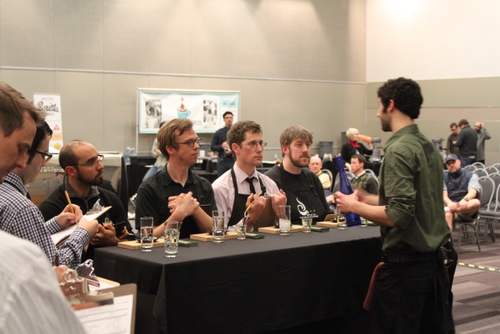
The head judges have the role of making sure that the sensory judges and technical judges are judging in a consistent manner. They taste all of the drinks so that they have an idea of how the judges should score the drinks. If one judge has a score that is abnormally high or low, they can correct the score. Head judges have a lot to watch, but their scores do not count toward the competitor’s score. They essentially referee the other judges.
As you might imagine, there is a long list of technical and sensory specifications that the judges are looking for (If you’re interested, the rules and regulations for the Barista Championship can be found here). It takes both technical skills and presentation skills to be a champion. According to the USBC rules, a champion barista is someone who:
- Has mastery of technical skills, craftsmanship, communication skills and who is passionate about their profession, in addition to service.
- Has a broad understanding of coffee knowledge and serves high quality beverages.
- May serve as a role model and a source of inspiration for others.
In other words, a barista has to have the skills and passion necessary to be an ambassador for the specialty coffee industry. That is the overarching goal of these championships—to promote the craft of specialty coffee and elevate the standards of coffee as a beverage.
The baristas have 15 minutes to make a total of 12 drinks: four single espressos, four cappuccinos and four specialty drinks they have created on their own. They have to work quickly and efficiently as they describe to the judges what they are doing. The limited amount of time adds pressure to the competition. A large red LED timer is posted at each station and during the competition, you can feel the tension in the room rising as each barista nears the allotted 15 minutes. Most of the baristas finished on time, but there were a few who didn’t quite make it. They generally got hung up when they made their specialty beverages too complex.
To give you a better idea of the way the competition goes, I shot some video of Ashley Rauch, from Sterling Coffee Roasters in Portland, explaining her espresso selection to the judges. She was competing in her first competition and was a little nervous, but she did a nice job (and finished within the time limits). You can see how she put a lot of thought into her presentation. Take note of her descriptions of the complex aromas and flavors that the judges can expect when they taste the espresso.
Being a barista is truly an art. I like to joke about the tattoos and interesting fashion that baristas are known for, but when it comes down to it, a barista’s skills make a huge difference in the way your drink tastes. They are the final step in a very long, complex process that brings the coffee from where it is grown to your cup. As Brandon said to me, if baristas think about how complex the process is to produce high-quality coffee beans, they should feel an obligation to prepare it in the best manner possible. As consumers, we should appreciate their efforts.
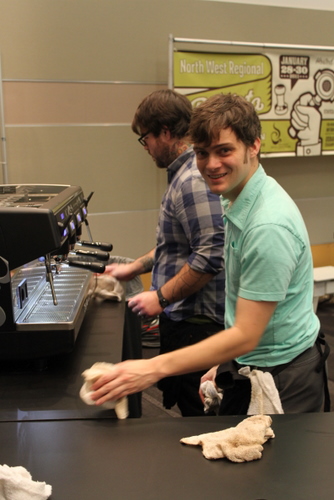
About half way through the competition, I was re-assigned to busing tables. After each round of drinks was judged by the sensory judges, I had to help remove the drinks from the table. It was more fun than station maintenance because I had a closer view of the baristas in action and could more easily taste the drinks that the baristas made.
Speaking of tasting the drinks, I probably tried about 40 different beverages throughout the day. Even though I had just a sip of each one, all of the sips added up and by the end of the competition, I was floating around in a caffeine-induced haze.
The drinks I tried varied in quality. On our way up to Tacoma, Brandon and I had talked at length about what went into making a good cappuccino. He told me that the espresso needs to be able to stand up to the milk and create balance. Some of the more floral single-origin espressos tend to disappear when they are mixed with milk, making the cappuccino unbalanced. At the competition, I probably tasted 15 different cappuccinos and now I understand what he was talking about. Some of them had very little coffee flavor, while others were much more balanced between the milk and the coffee. That’s one of the reasons that people like Stumptown’s Hair Bender Blend. When it is used to make a latte or cappuccino, you can still taste the coffee.
Watching the competition, you could tell that some of the baristas really enjoyed the spotlight. Confidence and a flair for performing were definitely two characteristics that separated the better competitors from the rest. On the first day of competition, Laila Ghambari of Stumptown Seattle and Ryan Wilbur of Stumptown Portland were the two competitors who seemed to most enjoy performing, so it was no surprise to me when they made the finals.
While most of the competitors at a competition work for a café, there are a few independents that compete too. One independent was Rick Cox, a self-described “super-passionate home barista” from Auburn, Washington. He developed a routine and competed at the NWRBC without support from a café. He didn’t make the finals, but hats off to him for having the courage to try. Becoming a competitive barista requires lots of practice, and the baristas who spend hours each day at their cafés honing their skills naturally have an advantage over non-affiliated baristas.
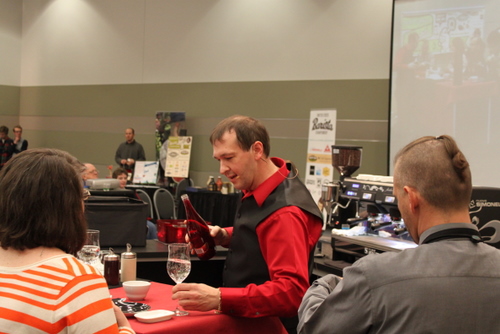
Even though it is a competition, the baristas are generally friendly and supportive of one another. They want each other to do well, because they know that ultimately, they are all trying to do the same thing—to help spread the word that producing specialty coffee is an art form. It is not something that can just come out of a machine (McCafé, anyone?). It takes skill, practice and pride in the craft to become a great barista and that is why when you go to a great café you should always be appreciative of what the baristas are trying to do. They work hard to help you experience the coffee in the same way that they do.
After watching and helping with nineteen different performances over six hours, I left the convention center tired, but thankful that I had been a volunteer. It was much better to be an active participant than just a spectator. I learned a lot about what it takes to become a top-notch barista and enjoyed my front-row view. Next year, when the regional competition comes to Portland, I may try to become a judge. It would be a great way to learn more about this thing called specialty coffee, because once you start learning, you don’t want to stop.